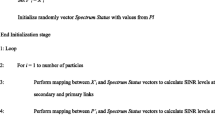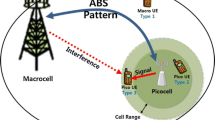Abstract
In cognitive heterogeneous network, when multitudes of femtocells coexist, effective resource management become important to enhance network performance. Based on the base station location and terminal distribution density, we propose spectrum management and power configuration scheme for femtocells deployment network. In the beginning, we consider two femtocells adjacent network and propose the resource management scheme. The scheme allocates time frequency resource by adopting complete reusing and private usage in non-overlapping and overlapping areas respectively. Subsequently the scheme optimizes base station power under the constraints of cross-tier interference and maximal transmission power to maximize network capacity. According to the analysis of the power variation effect to femtocell coverage, a near-optimal solution of the transmission power is derived, and the corresponding power configuration scheme is proposed. After then we extend the spectrum and power management to multiple femtocells coexisting networks, and propose the management scheme applied for multiple femtocells deployment networks. The simulation results indicate that in capacity performance, the proposed power solution is close to the optimal solution, and the proposed resource management outperforms the existing schemes.














Similar content being viewed by others
References
Zhang, H., Jiang, C., Beaulieu, N., Chu, X., Wen, X., & Tao, M. (2014). Resource allocation in spectrum-sharing OFDMA femtocells with heterogeneous services. IEEE Transactions on Communications, 62(7), 2366–2377.
Shakir, M. Z., & Alouini, M.-S. (2012). On the area spectral efficiency improvement of heterogeneous network by exploiting the integration of macro-femto cellular networks. In IEEE international conference on communications (pp. 5695–5700). Ottawa: Canada.
Shakir, V. C., & Andrews, J. G. (2009). Spectrum allocation in tiered cellular networks. IEEE Transaction Communication, 57(10), 3059–3068.
Song, F., Wen, X., Li, N., et al. (2013). Power allocation for OFDM-based cognitive heterogeneous networks. Science China, 58(4), 1–12.
Chen, F., Xu, W., Guo, Y., Lin, J., & Chen, M. (2013, Aug.). Resource allocation in OFDM-based heterogeneous cognitive radio networks with imperfect spectrum. In The 8th international ICST conference on communications and networking in China (CHINACOM) (pp. 46–51 ). Guilin:China.
Cheng, S., Lien, S., Chu, F., & Chen, K. (2011). On exploting cognitive radio to mitigate interference in macrofemto heterogeneous networks. IEEE Wireless Communications, 18(3), 40–47.
Xie, R., Yu, F., Ji, H., & Li, Y. (2011). Energy-efficient resource allocation for heterogeneous cognitive radio networks with femtocells. IEEE Transactions on Wireless Communications, 11(11), 3910–3920.
Jagadish, G., & Catherine, R. (2013). Resource allocation, transmission coordination and user association in heterogeneous networks a flow-based unified approach. IEEE Transactions on Wireless Communications, 12(3), 1340–1351.
Wang, S., Zhou, Z., Ge, M., & Wang, C. (2013). Power allocation for OFDM-based cognitive heterogeneous networks. IEEE Journal on Selected Areas in Communications, 31(3), 464–475.
Adian, M., & Aghaeinia, H. (2014). Optimal resource allocation in heterogeneous MIMO cognitive radio networks. IEEE Wireless Personal Communication, 76(1), 23–39.
Zhang, H., Jiang, C., Mao, X., & Chen, H. (2015). Interference-limited resource optimization in cognitive femtocells with fairness and imperfect spectrum sensing. IEEE Transactions on Vehicular Technology, 10(2), 1–11.
Bu, S., Yu, F., & Qian, Y. (2013). Energy-efficient cognitive heterogeneous networks powered by the smart grid. In: Proceedings IEEE INFOCOM (pp. 23–39). Anaheim: America.
Peng, X., Peng, G., Hyun-Park, J., Park, D., & Ky-Kim, D. (2009). Max–min fairness based radio resource management in fourth generation heterogeneous networks. In The 9th international Symposium on communications and information technology (pp. 208–213). Icheon: Korea.
Zhang, H., Jiang, C., Beaulieu, N., Chu, X., Wang, X., & Quek, T. (2015). Resource allocation for cognitive small cell networks: A cooperative bargaining game theoretic approach. IEEE Transactions on Wireless Communications, 14(6), 3481–3493.
Zhang, H., Chu, X., Guo, W., & Wang, S. (2015). Coexistence of Wi-Fi and heterogeneous small cell networks sharing unlicensed spectrum. IEEE Communications Magazine, 53(3), 158–164.
Zhang, H., Liu, H., Jiang, C., Chu, X., Nallanathan, A., & Wen, X. (2014). A practical semi-dynamic clustering scheme using affinity propagation in cooperative picocells. IEEE Transactions on Vehicular Technology, 99(8), 1–11.
Lin, X., Andrews, J., & Ghosh, A. (2013). Modeling, analysis and design for carrier aggregation in heterogeneous cellular networks. IEEE Transactions on Communications, 61(9), 4002–4015.
Choi, Y., Lee, Y., & Cioffi, John M. (2011). Optimization of cooperative inter-operability in heterogeneous networks with cognitive ability. IEEE Communications Letters, 15(11), 1178–1180.
Ghimire, J., & Rosenberg, C. (2013). Resource allocation, transmission coordination and user association in heterogeneous networks a flow-based unified approach. IEEE Transactions on Wireless Communications, 12(3), 1340–1351.
Acknowledgments
This work was supported by the National Natural Science Foundation of China (NSFC) (Grant No. 61402107), Doctoral Scientific Research Foundation of Guangdong Province (Grant No. ZJ121204), Natural Science Foundation of Guangdong Province (Grant No. 2015A030313652) and Guangdong Province Commonweal Research Technological Project (Grant No. 2015A010103019, 2015A010103020)
Author information
Authors and Affiliations
Corresponding author
Rights and permissions
About this article
Cite this article
Zhang, G., Liu, H., Lin, K. et al. Terminal density dependent resource management in cognitive heterogeneous networks. Wireless Netw 23, 1509–1522 (2017). https://doi.org/10.1007/s11276-016-1235-x
Published:
Issue Date:
DOI: https://doi.org/10.1007/s11276-016-1235-x




